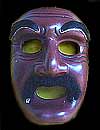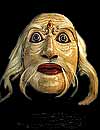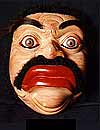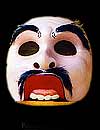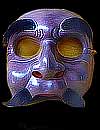Why masks and stylised make-up? To make these ancient plays work on the contemporary stage, the theatrical world that is created for the audience needs to be somehow "special" and "different." Significant figures like gods and mythical heroes shouldn't be like ordinary people on the street -- they should have an element of the "fantastic", something that sets them apart from the everyday. Anyway, characters in classical plays are not so much individuals as types who display "archetypal" characteristics. So we've chosen to make use of masks and "painted face" make-up both to intensify the theatrical experience for the audience and as a means of moving away from realist focus on characters as particular individuals so that characters can be understood as more than, other than, merely human. Why Balinese masks? Yana knew that I'd been studying Topeng mask carving and dancing in Bali and discussed with me the idea of using this theatrical language in a production of Hippolytos. It seemed to make a remarkably good fit -- Balinese Topeng ("topeng" means mask) is a dance drama based on historical chronicles of the mythical kings and heroes of Bali, so this Greek story featuring the great hero Theseus, his tragic son and doomed young wife seemed appropriate for the genre. In Bali we commissioned my teacher, Agung Ngurah, to create masks based on Balinese Topeng characters. I supervised the work and helped to carve and paint the masks (made entirely by traditional methods) over a period of two months. Masks were used in ancient Greek theatre for a number of practical reasons: to allow performers to play more than one role; to make faces visible from a distance for a large audience and to clearly indicate type -- gender, class, function. We use masks in Hippolytos for a lot of the same reasons. Members of the chorus don masks in order to act the principal roles of Hippolytos, Phaedra, Theseus and the Nurse and are able to return to the chorus when they remove the masks. The masks have vivid, vibrant expressions visible from a distance and they are derived from established types: Dalem, the beautiful young King, for Hippolytos; Patih, the warrior and chief minister of state, for Theseus and Putri, the princess, for Phaedra. We decided that the masks of the human characters should be flesh-coloured, while the masks of the goddesses Aphrodite and Artemis should be white, the colour of refined, high ranking halus characters in Balinese Topeng. Isn't there a conflict of styles mixing Balinese Topeng with "Jaipongan", a contemporary dance genre from west Java? I don't think so. First of all, both Indonesia and Greece are essentially nations made of many islands, each of which has a distinct local culture, but which collectively share certain cultural characteristics and elements of a common history. The history and cultures of Java and Bali are interconnected in all sorts of ways and Balinese Topeng dramas mostly concern events of the Majapahit period (14th-15th centuries) when Java and Bali were one kingdom. There are, of course, various traditions of Topeng in Java and a tradition specific to Sunda (West Java), however the style of both music and dance in that tradition is rather less dynamic than that of Bali. We juxtapose different but related styles in order to heighten their theatrical effect. The delicate legato quality of the chorus dances set against the powerful, sudden movements of the Balinese Topeng characters creates an exciting and dramatic contrast. This is further intensified by the percussion accompaniment by live musicians (from the Balinese Gong Kebyar ensemble Lila Cita) and a cak chorus (derived from the famous Balinese "Monkey Chant") which interacts with the performers. The combination of these various elements--Greek chorus, Javanese dance, and Balinese Masks--within a scenic design which uses aspects of each of those cultures produces a unique and surprisingly homogeneous theatrical world for this play. The old story is made new, strange and exciting. I suspect it would play as well in Bali, Java, Greece or even Japan as it has in London. Thiasos' production of Aristophanes' comedy Wealth seemed to come from a completely different world. What was the source of that stylised make-up? For Ploutos, we have taken a different tack and made use of abstract make-up designs derived from the comic "painted faces" characters of jing xi, popular Chinese Opera. The "painted faces" are comic characters and there is enormous variation in the make-up designs depending on the particular characteristics of these stock characters. The iconography is so complex that it is not fully understood even by many Chinese Opera devotees. We modified some of the "classic" painted-face designs to make them work with the faces of the actors and the physical life each created for his or her character. How did that work? Here you can get an idea of Thiasos' collaborative way of working. We began with the idea of the 19th century Greek shadow-puppet theatre called Karagiozi (itself derived from Turkish and Egyptian puppets that may have had their origin in the shadow puppets of India) -- aspects of which are reflected in of the set and costume design. It was impractical for the characters to actually move like their shadow puppet models, but we wanted to create a stylised puppet-like quality in the movement. To find this we initially used animal work so that each of the actors could find an animal from which the physical life of the character could be developed. At this point our designer, Abdel Farrah, came to see the work and suggested a make-up based on the Chinese painted faces -- this would provide the startling stylisation we desired without interfering with the movement of the actors' faces. In fact, the make-up intensified the effect of their mobile features while providing the puppet-like quality we had in mind. As the physical characterisations developed, so did the make-up designs with the result that we had a strong visual language which identified each character. The movement, music, text and visual elements work together to create an organic whole from these seemingly disparate elements.
|
||||||||||||||||||||

